#geiko shimada hairstyle
Text
The look of... VIII: Shimizu 清水

Historical context
The first official date in the history of Shimizu Geigi is 1872, when "Machi Geisha" (まち芸者), who were distinct from "Kaku Geisha" (廓芸者), appeared. A Kenban (registry office) was established in 1877. At that time, Machi Geisha and Kaku Geisha combined were around twenty people. Only ten years later, in 1887, their number had increased to 100. The number of Geigi continued to grow.
In 1938, the number of Geigi was around 260, and they were highly regarded nationwide for their skills in art and behaviour. In 1951, a "Shimizu Geigi school" (清水芸妓学校) was opened, around 150 Geigi attending the event.

In the 1970's, Japan's period of economic growth started tapering off, interest in traditional arts dwindeled, which resulted in less work opportunities for Geigi and the number of Ryotei decreasing. In response to this, local business leaders and Shimizu Geigi started an organisation to help fostering new Geigi (Seibikai 清美会).
By 1985, their number had decreased to thirteen and the Kenban closed. In 1991, local businessmen and Geigi formed a different company (Seibi Co. 清美(株)), which worked as employer for Geigi. Due to a bad economic environment, Shimizu Odori (清水をどり) was last held in 1998, Seibi Co. was dissolved in 2004, and Haru no mai (春の舞) was discontinued in 2009. As a result of this, some of Seibi's employees became independent Geigi.
Allegedly, the number of Geigi hit rock bottom in 2011 with only two remaining. However, in 2012, around eleven Geigi worked in Shimizu. Since then, the city had a steady stream of Geigi coming and going again. At the end of this year, 2023, there are ten Geigi working in the city.
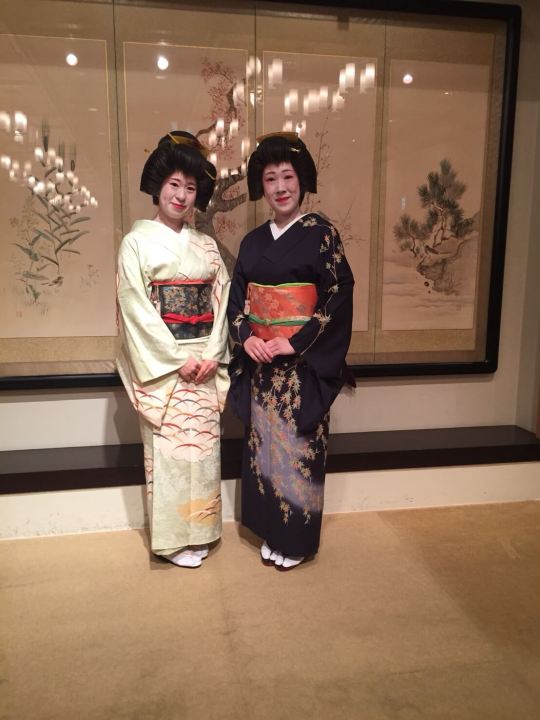
The look of Shimizu Geiko
Local Term: Geigi 芸妓
※ Hairstyle: Taka shimada, Tsubushi shimada
※ Kanzashi: Kushi, Maezashi, bekko kogai, ear of rice in the new year period
※ Kimono: Homongi, Kuromontsuki Hikizuri
※ Haneri: white
※ Obi: Taiko musubi
※ Obiage: green, pink, white, red
※ Obijime: flat, 1 knot
※ Footwear: Zori

Casual look
※ Hairstyle: Yohatsu
※ Kanzashi: none
※ Kimono: Homongi, rarely Komon
※ Haneri: white
※ Obi: Taiko musubi
※ Obiage: white, pink
※ Footwear: Zori

The look of Shimizu Maiko
Local term: Shinjin Geigi 新人芸妓
※ Hairstyle: Momoware Katsura, sometimes real hair styled (shin nihongami)
※ Kanzashi: seasonal and non-seasonal Hanakanzashi, Katsuyama, maezashi, Shidare in all age groups
※ Kimono: Furisode with shoulder tucks or no tucks at all
※ Eri: white with white embroidery, plain white, white with multicolour embroidery, other colours possible especially during summer months
※ Obi: Koken musubi
※ Obiage: flat, mostly red/silver, red/white shibori, other colours also possible (green/beige/light blue)
※ Obijime: flat or round with 1-4 knots. No obidome
※ Footwear: Zôri


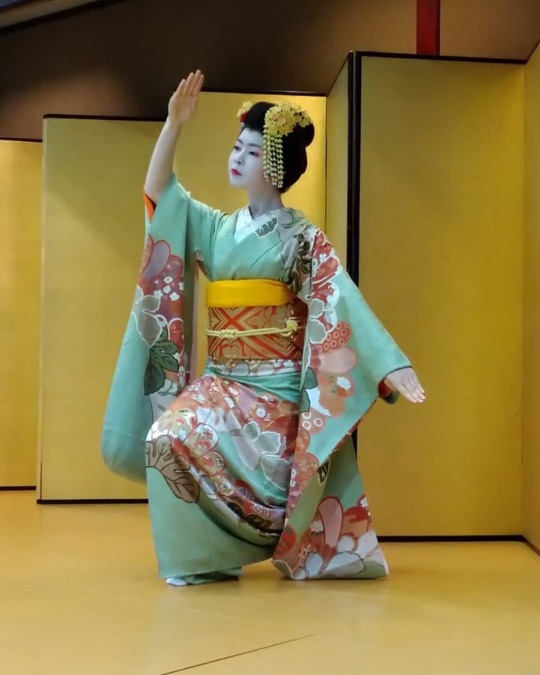

Notes
Shimizu was merged with Shizuoka in 2003. Shimizu Geigi and other traditional arts performers are backed by 静岡伝統芸能振興 Shizuoka dentô geinô Shinkô-kai/Shizuoka traditional performing arts promotion association, which is the successor to Seibikai. You might notice I didn't start this post with a historical b/w photo. There are some old photos on the Shizuoka Dentogeino homepage, but they are the size of a postal stamp. And that's it. I feel let down. No chance to explore the historical style of Shimizu.
Anyways. "The look of Shimizu/Shizuoka" was requested by @geimaiko. The layout of this post is based on geimaiko's own. Also... geimaiko originally started these series. If you liked this post, you should go and thank her, because without her, there would be no "the look of..." ;)
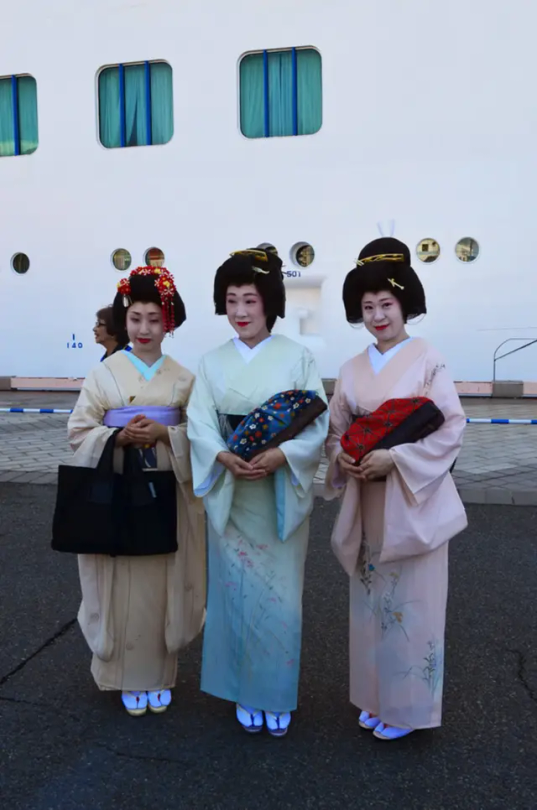

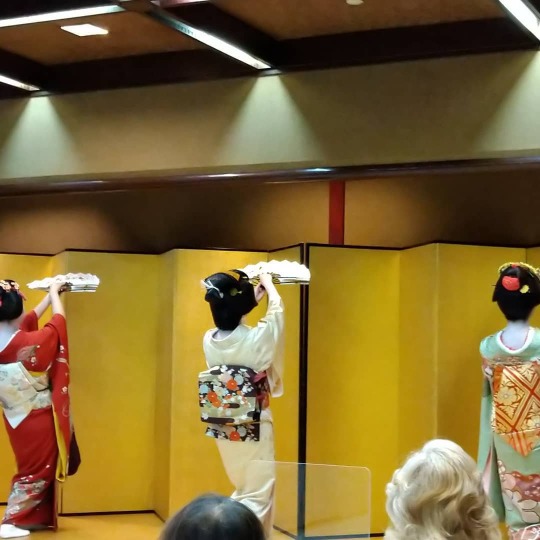
Sources
https://www.shizuoka-dentogeino.jp/geigi/shizuoka_history/, https://www.shizuoka-dentogeino.jp/geigi/shimizu_history/, http://www.shimizu-port.jp/geigi.html, https://www.nikkei.com/article/DGXNZO41971500Z20C12A5L61000/ (headline and preview only), https://www.youtube.com/@shizuokadentogeino/videos
Pictures: Komachi May 17, Makoto May 17, Komachi+Makoto Oct 17 (sources nowhere to be found), Sakurako+Fukutaro Apr 22, Kikuno+Umeka Nov 14, Iroha Jun 20, Iroha Oct 20, Fukutaro Oct 20, Ichiryo+Komachi+Makoto ~2016, Komachi+Sakurako Apr 18, Fukutaro+Sakurako Oct 18, Iroha+Fukutaro+Sakurako Oct 20
#mg#geisha#geiko#maiko#hangyoku#geigi#shizuoka#kimono#komachi#makoto#sakurako#fukutaro#kikuno#umeka#iroha
48 notes
·
View notes
Note
Why do geiko style their own hair for the miyako odori ? And is it in the same hairstyle their wigs are in ?
Geiko style their hair in the kyofu shimada style for the tea ceremony of the Miyako Odori as a way of keeping traditions alive. Geiko in other districts will also style their hair in the kyofu shimada style for the tea ceremony at their odori too. A geiko's wig is in the geiko shimada style, which is a variant on the taka shimada style ^^
11 notes
·
View notes
Text

May 2019: Famous Geiko Marika (Tsurui Okiya) of Gion Kobu hosting a tea ceremony.
Source: Masanobu Kido on Instagram
#marika#tsurui okiya#gion kobu#tea ceremony#kimono#hikizuri#susohiki#kosode#obi#obiage#obijime#oshiroi#makeup#katsura#wig#geiko shimada hairstyle#hairstyle#hair#hairpin#hair ornament#comb#kushi#geisha#geiko#geigi#maiko#nihongami#geisha makeup#shironuri#tomesode
191 notes
·
View notes
Video

Geiko Tomeko, sometime around the 1930s | src Blue Ruin
#Geiko#Maiko#Geisha#Kimono#Japan#Japanese#Showa period#Eri#Hairstyle#Shimada#Obiage#Kanzashi#Tomeko#Kyoto#portrait#portraying#1930s#traditional clothing
83 notes
·
View notes
Text
it’s been ten billion years since i’ve written a naboo headcannons post but the idea of writing one on foodstuffs and on textiles is. so tempting (honestly the textiles one is one that i would, ideally, do a whole series on for different planets and systems (and therefore different cultural/religious values, etc.) but this is, for now, simply An Idea)
and what’s giving me pause is how to reckon with the racist reasoning that lay behind the development of, in particular, the portrayal of naboo monarchy as something ‘alien’ and ‘intimidating’ while literally just copy+pasting japanese (lilac visitation robes (kimono), foreign residence gown (shimada hairstyle, probably more specifically the geiko shimada) and monogolian (senate outfit, headdress of a married khalka woman) attire, whereas her (romantic, familiarly (read: western) feminine) outfits in aotc were more inspired by european dress - right now i’m thinking of having high class naboo food culture be based on japanese and mongolian, while the lower class culinary traditions would be italian/french. the only scenes i can think of that feature food are both in aotc, with the pear scene and the deleted scene at padmé’s family’s home, which i would have to watch again for more ‘clues’. and probably easier to travel undercover as a lower class, so once again that could be used to bulk up this thesis
even with the space pear i could extrapolate an huge amount of what-ifs and guesses, i.e. pears have two domestication centers (china and central asia, and caucasus region), so it would ‘make sense’ for padmé to be eating higher class foods while at an official senatorial residence, vs. whatever foods her family would serve at home. but again. i don’t know if i’ll ever write this stuff up - right now it’s just an interesting thought exercise
#yes these are my current research interest areas. why do u ask#personal#this stream of consciousness post has a bibliography i'm kjhskjdf#other ppl concerned w/ worldbuilding: how long does it take to travel between systems? what's the time measuring system?#me: Where Did That Pear Come From And What Are The Implications Of It On Naboo Culture And Society.
24 notes
·
View notes
Photo









Source: http://nihongami.blogspot.com/2019/12/blog-post_8.html
Nihongami: Hairstyles of the Karyukai - Geisha & Maiko
Historical Time Period: Mid-Edo Period - 2nd Half (1753-1789)
Hairstyle Name: Chuu-Taka-Shimada (中高島田) lit. "Middle-High Rice Paddy Island”
This is a Shimada topknot with a middle-to-high base for the knot. The form of this hairstyle is nearly identical in the Bunkin-Taka-Shimada, Hariuchichi, Yakko-Shimada, and Geiko-Shimada styles. It seems to have occurred in various forms since the mid-Edo period. Its elegance and dignity of form makes it one of the favorite styles of the upper classes, especially the samurai class, by the late Edo period.
This is now widely used by traditional brides during the wedding ceremony as well as by the maiko and geiko of Gion Kobu during the performances of Miyako Odori. It is used only for the final common dance when all the performers dance together. Today, it’s unlikely to see any geisha on the street wearing this hairstyle. The floral decoration for this hairstyle changes every year because it is designed annually for each Miyako Odori performance.
#kimono#nihongami#edo#edoperiod#edonihongami#chuutakashimada#chuushimada#shimadamage#nihongamitimeline#nihongamitimeline03#nihongamitimeline03e#chushimada#shimada#chuudakashimada#chuudaka#chudaka#chudakashimada#chuu#daka#taka#chu#miyakoodorinochuushimada#chuutaka
12 notes
·
View notes
Photo

Geiko Umechika with Maiko Umehina, Fumiyuki (Katsufumi okiya) and Umesana showing all stages of GeiMaiko. Umesana as a first year Maiko with a dangling kanzashi, Fumiyuki who already finished her first year but is still junior Maiko, Umehina with Yakko Shimada, a hairstyle only for special occasions and only worn by senior Maiko and finally Geiko Umechika who finished all stages of a Maiko, had her erikae and is now independent
(SOURCE)
#umeno#kamishichiken#2019#april#maiko#geiko#katsufumi#red#green#yakko shimada#wareshinobu#kanzashi#umehina#umesana#fumiyuki#umechika
78 notes
·
View notes
Photo

A Geiko (Geisha) dressed in the Genroku style, with her hair in the Shimada-mage hairstyle of the Middle Edo period (1688-1715). It is believed that the yujo (ladies of pleasure) of Shimada created the hairstyle. 1920s, Japan. Text and image via Blue Ruin 1 on Flickr
432 notes
·
View notes
Video
<strong>Geiko Tomeko 1930s <a href="https://www.flickr.com/photos/blue_ruin_1/">by Blue Ruin 1</a></strong> <br /><i>Via Flickr:</i> <br />This is one of my favourite photos of a Geiko (Geisha) sometime around the 1930s.
#Geiko#Maiko#Geisha#Kimono#Japan#Japanese#Showa period#Eri#Hairstyle#Shimada#Obiage#Kanzashi#Tomeko#Kyoto
41 notes
·
View notes
Text
Maiko – Apprentice Geisha
Maiko are apprentice geisha (geiko). They are only found in Kyoto and are often used as the ultimate symbol of Japan. Maiko are a rare breed now, only several at any one time and confined primarily to the Gion and Pontocho districts.
Maiko are easily recognised by their attire. In the Japanese way, as young girls before they become women, the dress of the Maiko is more outlandish than that of the mature Geisha. The Obi and Kimono of a Maiko is brightly coloured and ornately decorated, the Kimono is of the Furisode style (more specifically of the oburisode type kimono) with long flapping sleeves that fall to the floor. The collar of the under-kimono worn by the Maiko is usually of a red and white patterned material, and shows vividly against the white neck of the Maiko.
Maiko move through several stages of maturity as their apprenticeship continues. Numerous highly ritual costume changes are made to identify these passages of time. Maiko have several different hair styles, makeup complexity changes and the pattern of the collar moves from colourful to demure and white. These changes are physical indicators of the maturity of the girl moving from flighty and girlish to demure and womanly.
A first-year maiko continues to only paint her bottom lip, and she wears long, dangling shidare kanzashi. Her collar is predominantly red with small patches of white embroidery, and her hikizuri kimono usually has a busy pattern. Once she finishes her 1st year of apprenticeship she will begin painting her upper lip, and stop wearing shidare kanzashi. Tomitae of Gion Higashi as junior maiko.
A maiko becomes a senior when her okaasan thinks she has earned it through her dancing and musical accomplishments, usually around the 3rd year of apprenticeship. At this point her eri will be completely embroidered so it is white, and her hairstyle changes to ofuku. Over the next year or two the colour of the tegarafolded cloth in her hairstyle will change to show her seniority. Tomitae of Gion Higashi as senior maiko.
The Obi of a Maiko is longer than any other traditional kimono obi and tied in an ornate style rather than the box knots common in the Obi of both Geisha and other Japanese women. The Obi is tied very high on a Maiko, coming high into the arm pit, with the knot reaching almost to the collar and the ends falling to the floor. Maiko also wear distinctive Okobo, large platformed wooden shoes, which taper to a smaller point on the sole, these are often lacquered and ornate. Okobo usually force a young Maiko to take very small steps, which is considered attractive by Japanese tradition.
Maiko use their own hair for their elaborate traditional hair styles rather than the wigs that contemporary Geisha wear. Traditionally it is a sign of a productive and hard apprenticeships to have a small bald patch from the ornate hair styles but as apprenticeships grow shorter and wigs more common this is a fading sign of a retired Geisha. The hair ornaments for a Maiko are plentiful and extravagant and are matched to the current season, usually displaying a fall of seasonal flowers constructed from beads.
Two to three months before her erikae (graduation), a maiko will begin tying her obiage and tucking it behind her obi. A month before her erikae she will wear a special hairstyle dependent on which district she is from; In Gion Kobu she would wear yakko shimada, but in Pontocho she could wear any of around 5 different hairstyles. Tomitae of Gion Higashi with yakko shimada
Two weeks before erikae a maiko will wear sakkou hairstyle, with its accompanying outfit and ohaguro (blackened teeth) if she chooses. The outfit worn depends on which kagai she is from:
In Gion Kobu maiko wear kuromontsuki hikizuri, white eri, gold obi, and a special sakkou kanzashi.
In Gion Higashi maiko wear busily-patterned hikizuri, a gold-flecked red eri, a gold obi, and special sakkou kanzashi.
In Miyagawacho maiko wear kuromontsuki hikizuri, a gold-flecked red eri, gold obi, and a special sakkou kanzashi. Sometimes, instead of wearing kuromontsuki hikizuri, a maiko will wear an iromontsuki hikizuri of deep blue, brown or light blue.
In Pontocho maiko wear iromontsuki hikizuri of bla bold colour like blue or brown, with a gold-flecked red eri, gold obi, and a special sakkou kanzashi.
In Kamishichiken maiko wear iromontsuki hikizuri of brown, blue or pale pink, with a gold-flecked red eri, gold obi, and a special sakkou kanzashi. Sometimes, instead of wearing iromontsuki hikizuri, she will wear kuromontsuki hikizuri.
Erikae, “collar-turning”, is the graduation of apprentice to geiko, professional artisan. At this time the colour of her collar will change to a more demure white as in married women. Her elaborate sakkou hairstyle is undone and the top piece cut off so she can wear her custom-made katsura wig. She dresses in tomesode hikizuri kimono with shorter sleeves indicating her growing maturity.
While beautiful to look at Maiko are still young girls, so the social mastery they are expected to attain as accomplished Geisha is still not fully formed and Maiko are usually expected to dance, and be seen, and though performing tasks such as filling drinks they are not intended to entertain guests to the same degree as a Geisha. Young girls may become Maiko at 16, under current Japanese law, as all adolescents must attend high school to this age. A Maiko’s apprenticeship is usually 5 years, and so at 21 she may become a fully fledged Geisha.
Though not attending conventional school after becoming Maiko, they must nonetheless attend classes every morning in dance, Shamisen, singing and other art. Maiko as well as learning artistic pursuits must learn the social graces and old style Kyoto dialect before becoming a Geisha.
As such an identifiable icon of Japanese traditional culture the Maiko are often in demand, especially for photography. A popular tourist activity in Kyoto is to catch a photograph of a Maiko hurrying to an appointment.
2 notes
·
View notes
Photo

April 2017: geiko Chiyoko wearing striped kimono, hakata obi, and chu shimada hairstyle (special one for Miyako Odori performance) by nagayoshi.gofukuten on Instagram
༼ つ ◕◡◕ ༽つ Geisha-kai on P a t r e o n || Instagram
212 notes
·
View notes
Text
The look of... VII: Mukojima
Welcome to the 18th installment of this series (my 7th). This time, we’re having a look at the Geigi that work in one of Tokyo's Hanamachi: Mukojima (向島).
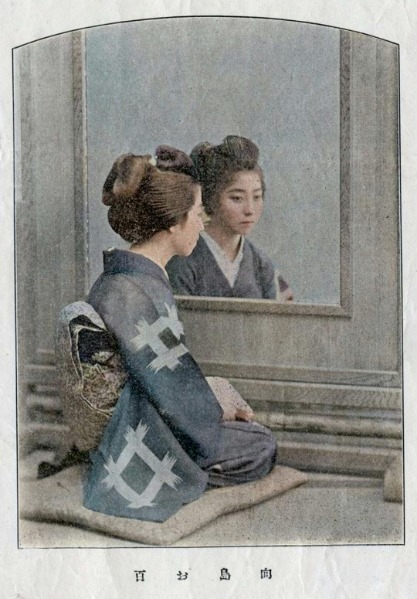
Historical context
Geisha started to live in Mukojima in the early Meiji period (1868-1912) [1]. From the Edo to Meiji period, Mukojima was a recreational area for the common people, and was frequented by Yanagibashi and Yoshiwara Geisha with their customers. [3] The earliest record of a Mukojima Geisha (known to me) is Omomo お百, who was featured in "Contemporary Beauties", 1897 [2]. In 1906, 30 Geisha lived in the area. By 1928, their number had increased to 239. In 1940, several Kenban united, further increasing the number of Mukojima Geisha to 1300. Like in all Hanamachi around Japan, the number declined steadily after the second world war. In 1951, their number was 600, in 1993 240 [7], in 1996 170, in 2007 120 [3], in 2020 around 90 [4]. This makes Mukojima approximately as populated as Gion Kobu and Tokyo's largest Hanamachi.
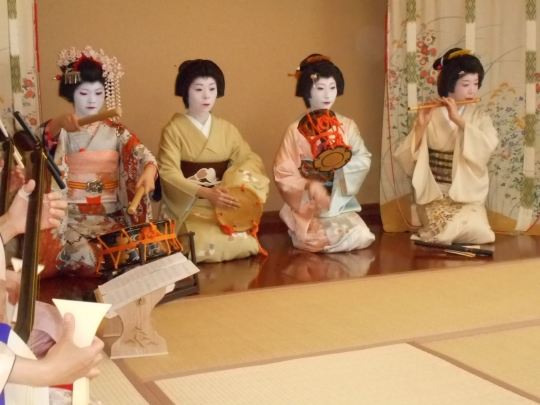
The look of Mukojima Geiko. Local Term: Geisha 芸者
※ Hairstyle: Geisha shimada, Tsubushi shimada
※ Kanzashi: Kushi, Maezashi, Hirauchi or Tama in the back, rice husk in the new year period
※ Makeup: Oshiroi
※ Kimono: everyday Kimono: Homongi. Kuromontsuki Hikizuri mostly in the new year period or for Erikae, rarely non-black Hikizuri.
※ Haneri: white
※ Obi: Taiko musubi, Yanagi musubi with Hikizuri
※ Obijime: mostly light-coloured. No obijime with yanagi musubi
※ Obiage: mostly red, pink, or white. Seldomly turquoise, white/green, white with red shibori (red/red-white shibori with Kuromontsuki)
※ Footwear: mostly Zori, also Geta



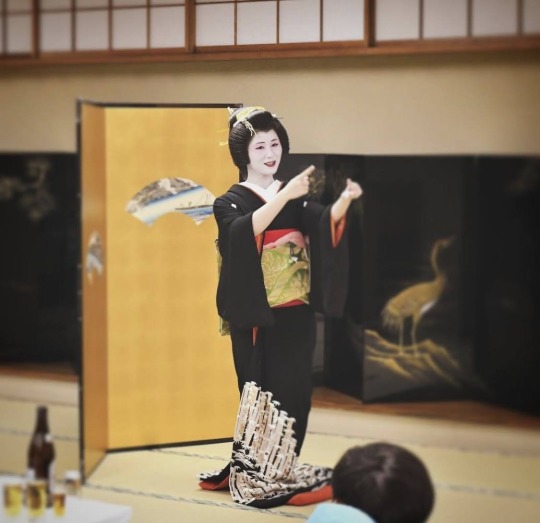
Casual/Jikata look
※ Hairstyle: Yohatsu
※ Kanzashi: none
※ Makeup: western makeup
※ Kimono: Homongi, Kurotomesode
※ Eri: white
※ Obi: Taiko musubi
※ Obijime: mostly light-coloured. In rare cases with pocchiri
※ Obiage: white with red shibori, pink, white, pink/turquoise
※ Footwear: Zori
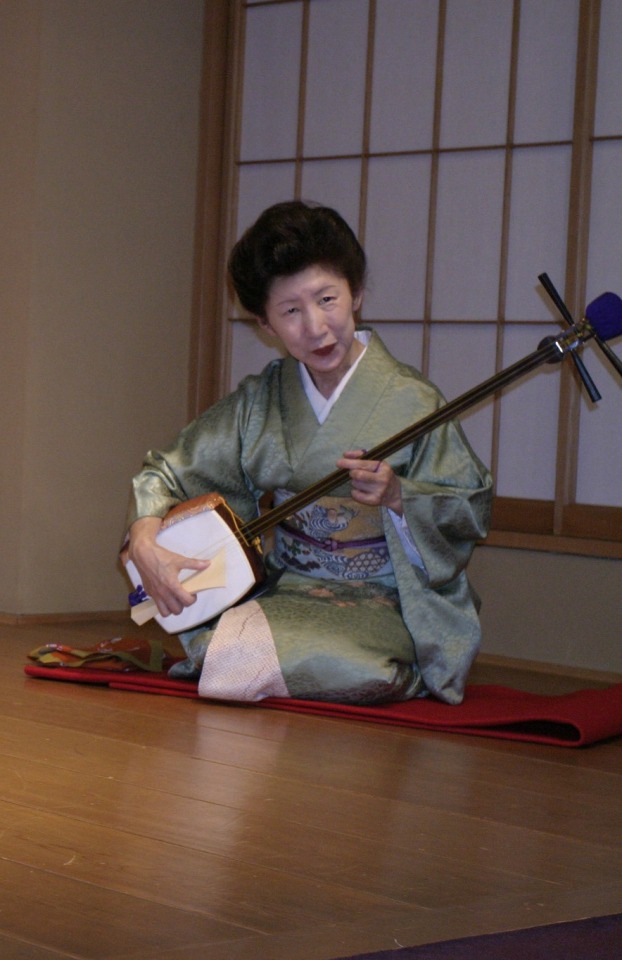
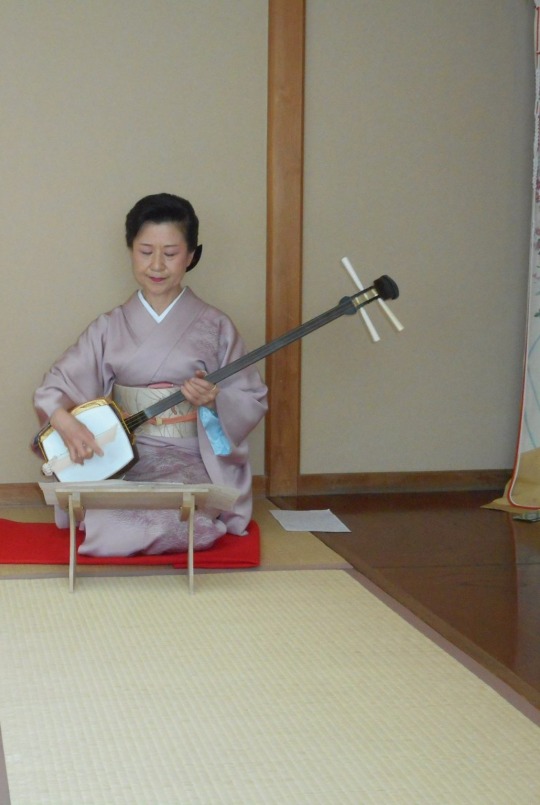
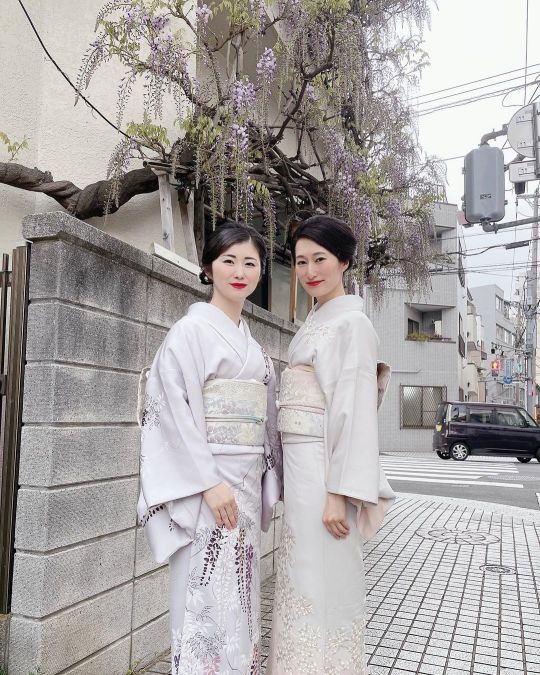
The look of Mukojima Maiko. Local term: Hangyoku 半玉
※ Hairstyle: Momoware (own hair or wig), Yuiwata for senior Hangyoku (only wig). Shibori, Kanoko and Chinkoro are mostly red, but can also be pink during summer.
※ Kanzashi: seasonal flower kanzashi (1-2 Daikan, Katsuyama, 1-2 Bira-Ôgi, Shidare popular for all ages), Maezashi (optional), Hirauchi. Minimal flower kanzashi with Yuiwata.
※ Makeup: Oshiroi, both lips painted from the start
※ Kimono: Furisode with or without tucks (all variations possible)
※ Eri: mostly white or red/white. But also pink/red, red/purple/green on white base, pink, green, black/pink/white, etc., etc.
※ Obi: kôken musubi
※ Obijime: light-coloured. sometimes with pocchiri
※ Obiage: most common colour variations are red/silver, or red/white shibori. But there are many other combinations.
※ Footwear: mostly Okobo (with red or pink straps), Zori
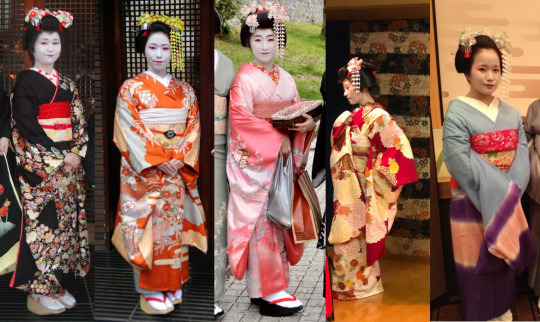
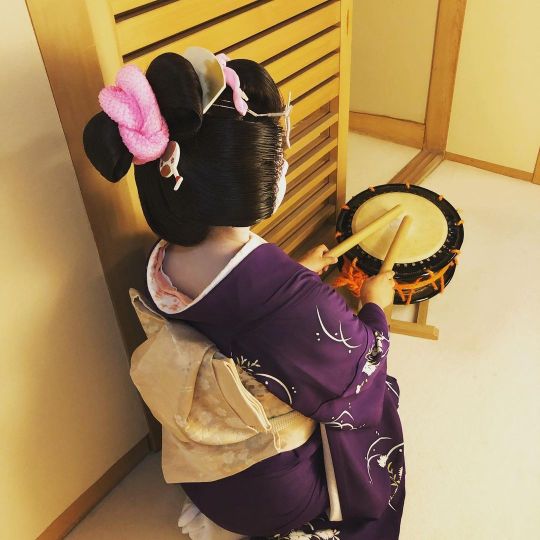
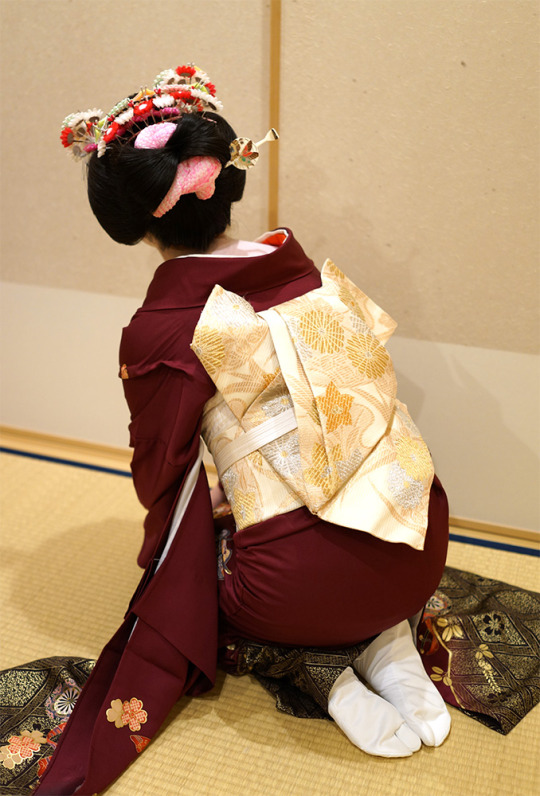


Dances [6]
Some dances that are local speciality of Mukojima:
※ Asazuma bune かさずまぶね
※ Fuji musume 藤娘
※ Fukagawa Kuzushi 深川くずし
※ Gorô ごろう
※ Mukojima ondo 向島音頭
※ O-Sumio お角力
※ Otemoyan おてもやん
※ Sôran bushi ソーラン節
※ Yosakuraya 夜桜や
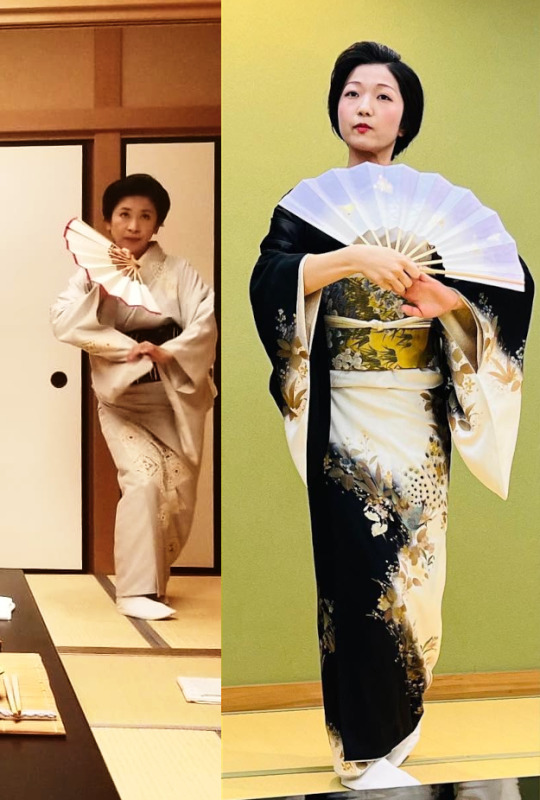
Others that you can also see in Ozashiki outside of Mukojima:
※ Ayame Yukata 菖蒲浴衣
※ Echigo Jishi 越後獅子
※ Hanami Odori 花見踊り
※ Hatsuharu 初春
※ Ina bushi 伊那節
※ Kiyari Kuzushi 木遣りくずし
※ Sawagi さわぎ
※ Setsuhonkaina せつほんかいな
※ Shichi fukujin 七福神
※ Takeda bushi 武田節
※ Tatsumi no hidarizuma 辰巳の左褄
※ Tsurukame 鶴亀
※ Yakkosan 奴さん
※ Yoshiwara Suzume 吉原すずめ

Notes
Mukojima allows part-time workers, calling them Kamome かもめ [5]. Most of them are students or work in a different job already. Their task is mainly assisting Geisha/Hangyoku in the Ozashiki. Kamome can become Hangyoku or Geisha if they wish to work full-time. Mukojima dancers also play instruments at ozashiki: Hangyoku frequently play shime-daiko, Tachikata more often play ko-tsutsumi, sometimes fue. Shamisen seems so be reserved for Jikata.
Usually, Ryotei and Okiya are separate businesses in Tokyo. In Mukojima, however, several Ryotei also function as Okiya [3], similar to how in Kyoto, several Ochaya also have an attached Okiya.

Sources - Text
[1] Foreign Press Center Japan, Mukojima Press Tour April 2006 https://fpcj.jp/en/assistance-en/tours_notice-en/p=6744/
[2] https://www.flickr.com/photos/blue_ruin_1/28442353867/
[3] numbers 1906-1951, 1996-2007: Sumi Asahara "Tokyo Rokkagai", 2007
[4] not an exact number (account required) https://www.tapatalk.com/groups/tsurukomaiko/hanamachi-population-reference-wip-t2000.html
[5] Kamome http://sengoku-japan.com/
[6] dances compiled at Tsurukomaiko, it's by no means a complete list (account required) https://www.tapatalk.com/groups/tsurukomaiko/list-of-dances-in-all-hanamachi-t1988.html
[7] 1993: Tsuiseki (追跡): The World of the Geisha, ca. 1993 https://www.youtube.com/watch?v=bkhRWNDwTyM
Sources - Pictures
Omomo ※ Kingyo Ozashiki ※ Momoka ※ Komachi ※ Yuki+Otokichi ※ Chikage ※ Senyume ※ Hiroya ※ Chikage+Natsuki ※ Tamaki ※ Shingetsu ※ Natsuki (twitter) ※ Soraka (insta) ※ Tomoka ※ Kingyo (fb) ※ Teruka 2x ※ Kanzashi ※ Kintaro (insta) ※ Ayame ※ Kingyo+Rin Ozashiki (fb) ※ Sakura matsuri 2023
I tried to trace back all pictures. If you find the missing links, let me know.
"The look of" other Hanamachi:
Yamagata, Tokyo Yoshicho, Niigata, Atami, Gifu, Tokyo Kagurazaka, Arima Onsen, Tokyo Asakua, Nagoya, Tokyo Shinbashi, Anjo
I Osaka Kitashinchi, II Tokyo Akasaka, III Osaka Nanchi, Fukuoka, V Yuzawa, VI Morioka
More Mukojima content: https://maigeiko.tumblr.com/tagged/mukojima
Layout: @geimaiko, thanks as always! ♥
70 notes
·
View notes
Note
Can you tell us what a nemaki is?
Nemaki has two different meanings depending on what it's applied to. A nemaki in the karyukai is the silver paper strip underneath the mage of the geiko's shimada hairstyle that signifies whether she is jimae or not. A nemaki kimono is used at hot springs resorts and is very similar to a yukata, but instead of having kimono sleeves it just has tubular sleeves ^^
15 notes
·
View notes
Text




January 2019: Geiko Fukuchō (Shigemori Okiya) of Miyagawacho showing off her unique, gorgeous formal kimono she wore during the new year’s celebrations.
This is so cool, I don’t think I have ever seen a kimono featuring a shrimp motif!
Source: tomoko.kikuehotel on Instagram
#fukuchou#shigemori okiya#miyagawacho#kimono#hikizuri#susohiki#kosode#kuromontsuki#obi#obiage#obijime#oshiroi#makeup#katsura#wig#geiko shimada hairstyle#hairstyle#hair#geiko shimada#nihongami#geisha makeup#shironuri#white makeup#geisha#maiko#geigi#geiko#tomesode#eri#karyukai
473 notes
·
View notes
Text
Setsubun Maiko Hairstyles
Setsubun, held in early February, marks the start of the new year in the lunar calendar. Geiko and maiko celebrate the lunar new year by dancing for the Shinto gods and goddesses at shrines (Yasaka for Gion Kobu, Gion Higashi, Miyagawacho and Pontocho; Kamishichiken celebrates at Kitano Tenmangu) and dressing up and performing skits (obake). A special privilege for senior maiko–and junior maiko, if their okaasan allows it–is wearing hairstyles they normally can’t wear the rest of the year. The exception to the rule is Pontocho, whose maiko wear these hairstyles, excluding fukiwa and tayū styles, before their sakkou period. For this year’s Setsubun I decided to put together a list of these hairstyles.
Clicking on the name of the hairstyle will redirect you to the photo’s source. Much of the information on the styles comes from ShotaKotake’s nihongami tutorials on DeviantArt. I highly recommend checking them out; they have information on a range of traditional hairstyles for men and women.
Finally, a special thank-you to @missmyloko, who edited this post for me!
Osome

This one is typically worn only by junior maiko, but occasionally senior maiko may wear it. It can be worn with or without miokuri (curled strips of ribbon) attached under the mage (”mass of hair”, what we might call the bun or topknot). Tayū may wear a larger version of this style. This style was mostly likely invented by a courtesan with the same name.
Oshidori no Hina

Originally developed from the yuiwata style, this hairstyle is supposed to resemble the plumage of a young male Mandarin duck. It was popular for new wives in Kyoto and Osaka during the Meiji (1868-1912) and late Edo Period (1600-1868).
Oshun

Kikugasane

A version of the shimada-mage, similar to the yuiwata hairstyle, created in the late Edo Period (1600-1868) to early Meiji Period (1868-1912). This woman runs a wonderful traditional hairstyle and clothing blog. Check it out to see more hairstyles!
Osafune

It can be worn with or without a piece of cloth wound through the mage.
Fukiwa

Some say this style was worn by princesses in the Edo Period (1600-1868), others say it was designed as part of a princess costume for the theater. It can be worn with or without miokuri.
Suisha

A version of the tsubushi-shimada, created in the Meiji Period (1868-1912). It can be worn with or without a piece of cloth wrapped around the mage. Supposedly this is one of the most difficult shimada styles to create. It closely resembles the Edo sakkou hairstyle.
Yuiwata

Another version of the tsubushi-shimada, popular with single women in the middle Edo Period (1600-1868).
Marumage
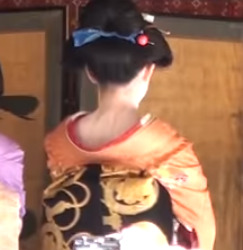
It’s a bit difficult to tell what exactly this hairstyle is, but it most closely resembles marumage, which was worn by women in their mid-20s. Marumage was the most popular version of the shimada hairstyle throughout the Edo (1600-1868) to Meiji (1868-1912) period.
Tayū (courtesan) hairstyles
These are hairstyles or variations of hairstyles worn by tayū or courtesans. They are very ornate, elaborate, and in my opinion absolutely stunning.
Yoko-hyogo

Developed in the mid-Edo Period (1600-1868) from the similar tate-hyogo style. Worn by high-ranking prostitutes–but not tayū–in the Yoshiwara and Shimabara red-light districts. Yoshiwara oiran (the highest rank of prostitute) wear a bigger version of of this style, the date-hyogo. (The original link to the image is missing.)
Tayū ofuku


Tayū ofuku replaces the tegara in maiko ofuku with two different colored pieces of cloth. The mage is also much higher. This hairstyle can take up to 3 hours to create. When maiko wear this hairstyle for setsubun they don’t add the tasseled flower kanzashi seen here.
677 notes
·
View notes
Photo









Source: http://nihongami.blogspot.com/2018/08/blog-post_11.html
Nihongami: Hairstyles of the Karyukai - Geisha & Maiko
Historical Time Period: Late-Edo Period (1789-1853)
Hairstyle Name: Yakko-Shimada (奴岛田) lit. “Servant’s Rice Paddy Island”
This is a pompadour-like hairstyle, which was popular among unmarried women of the samurai class during the Edo-period, borrowed stylistic elements from a hairstyle popular among the servant-retainers of samurai. Among modern-day maiko, this hairstyle is worn strictly with formal kimono on special occasions such as the celebration of the New Year (circa Dec. 13), Hassaku (circa Aug. 1) and in the last few weeks before becoming a geiko.
#kimono#nihongami#maiko#yakkoshimada#geisha#geishanihongami#nihongamitimeline#karyukai#karyukainihongami
24 notes
·
View notes

